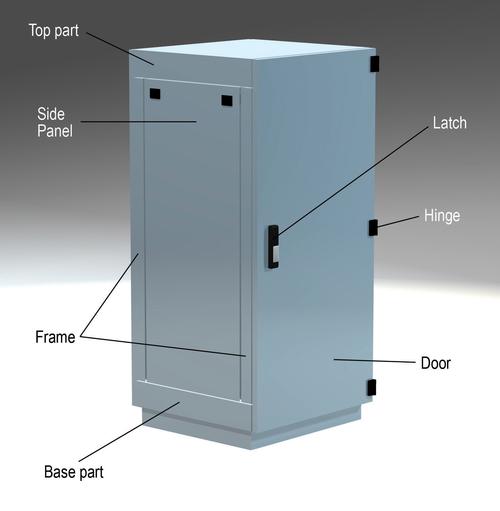August 26, 2011

Sheet metal enclosures consist of many individual components that are held together by various types of fasteners, which must be secure and resistant to movement.
The task of assembling an enclosure is known as panel joining. Side panels, rear panels, lids, floors, and brackets are all joined to make a simple enclosure. Once the enclosure is complete, doors are mounted and held in place with hinges. These hinges are commonly installed with fasteners, such as screws, but can be welded into place. To allow for opening and closing of the enclosure door, a handle or latch is also installed. For more complex enclosures, such as shelves, racks, windows, cooling equipment, etc., additional fasteners are required.
The selection of fastening and access hardware will also have an impact on other design criteria, such as speed of assembly, cost, functionality, and aesthetics -- even "design for disassembly" needed for maintenance of the enclosure, or when the product has reached the end of its lifecycle. All these design requirements will have an impact on the final product and will influence the fastening and access hardware selection.

Traditional fasteners, latches, and hinges have often been evaluated and selected based on functionality and aesthetics. Over the years, these products have evolved from simple basic designs to products with multiple built-in features and enhancements. While products have improved, the installation methods for these products have not significantly changed. They still consist mostly of screw-on, weld-on, riveting, or simple clip-in options.
Screw mount is a common method for joining sheet metal panels. A significant advantage of screw-mount products is that the screws can be removed and reinserted at any time. However, a disadvantage is that screw-mount installation requires a relatively long time to tighten the screws; it also requires mounting hardware such as nuts, bolts, and washers. Another significant concern is the possibility of losing components if the mounting hardware loosens over time and falls into and damages the sensitive equipment housed inside the enclosure. Additionally, it can be difficult to guarantee the screws are assembled to the desired tightness by a simple visual inspection.
Weld-on installation provides a strong bond between the surfaces and can be very precise. A disadvantage of the welding process is that it completely eliminates any ability to disassemble a panel for repair or maintenance. Plus, the heat incurred from the welding process can result in material property changes and distortions. In addition, only untreated or unfinished surfaces can be welded. Any surface finish must be applied after the welding process is complete. Because large surfaces on enclosures must be coated, the quality of the coating can be poor, as these panels often have covered corners, edges, and surfaces that are difficult to reach after the fastening and access hardware components have been welded in place.
About the Author(s)
You May Also Like





